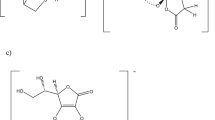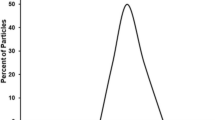Abstract
The induction of genotoxicity by Cr (VI) is dependent on its reductive activation inside the cell. Our recent studies have found that reduction of Cr (VI) by cysteine resulted in the formation of mutagenic Cr (III)-DNA adducts in the absence of oxidative DNA damage. In this work, we examined the formation of oxidative and Cr (III)-dependent types of DNA damage under a broader range of Cr (VI) and cysteine concentrations and investigated a potential role of this reducer in intracellular metabolism of Cr (VI). Peripheral lymphocytes from unexposed humans had 7.8-fold excess of glutathione over cysteine, whereas lymphocytes from stainless steel welders contained only 3 times higher amount of glutathione (p = 0.0009) which was entirely caused by the decrease in the concentration of glutathione. A strong correlation (r = 0.72) between the levels of both thiols was found in lymphocytes from controls. The number of DNA-protein crosslinks in lymphocytes from welders was 4.1 times higher than among controls, indicating the presence of Cr (VI)-dependent DNA damage. The average rate of Cr (VI) reduction by cysteine was approximately 5 times faster than that by glutathione. Higher reduction rate combined with the decrease in the intracellular concentration of glutathione should make cysteine a predominant Cr (VI)-reducing thiol in lymphocytes of welders. Analysis of the initial rates of Cr (VI) reduction by different concentrations of cysteine suggested the presence of one- and two-electron pathways, with one-electron mechanism dominating in the physiological range of concentrations. There was no detectable formation of DNA breaks or abasic sites under a broad range of Cr (VI) and cysteine concentrations, resulting in up to 68-fold differences in the rates of reduction and the production of as many as 3 Cr (III)-DNA adducts per 10 bp. The reactions with slow reduction rates (low concentrations of cysteine) led to the most extensive formation of Cr (III)‐DNA adducts. In summary, these results further establish Cr (III)-DNA adducts as the major form of DNA damage resulting from Cr (VI) metabolism by cysteine. The role of cysteine in reduction of Cr (VI) becomes more significant under conditions of occupational exposure to Cr (VI)-containing welding fumes.
Similar content being viewed by others
References
Sorahan T, Burges DC, Hamilton L, Harrington JM: Lung cancer mortality in nickel/chromium platers, 1946-1995. Occup Environ Med 55: 236–242, 1998
Mancuso TF: Chromium as an industrial carcinogen: Part I. Am J Ind Med 31: 129–139, 1997
Langardt S: One hundred years of chromium and cancer: Review of epidemiological evidence and selected case reports. Am J Ind Med 17: 189–215, 1990
Sen P, Conway K, Costa M: Comparison of the localization of chromosome damage induced by calcium chromate and nickel compounds. Cancer Res 47: 2142–2147, 1987
Biedermann KA, Landolph JR: Role of valence state and solubility of chromium compounds on induction of cytotoxicity, mutagenesis and anchorage independence in diploid human fibroblasts. Cancer Res 50: 7835–7842, 1990
Itoh S, Shimada H: Clastogenicity and mutagenicity of hexavalent chromium in lacZ transgenic mice. Toxicol Lett 91: 229–233, 1997
Landolph JR: Role of free radicals in metal-induced carcinogenesis. In: A. Sigel, H. Sigel (eds). Metal Ions in Biological Systems. Marcel Dekker, New York, 1999, pp 445–483
Snow E: Metal carcinogenesis: Mechanistic implications. Pharmacol Ther 53: 31–65, 1992
Sugiyama M, Wang X-W, Costa M: Comparison of DNA lesions and cytotoxicity induced by calcium chromate in human, mouse, and hamster cell lines. Cancer Res 46: 4547–4551, 1986
Cantoni O, Costa M: Analysis of the induction of alkali sensitive sites in the DNA by chromate and other agents that induce single strand breaks. Carcinogenesis 5: 1207–1209, 1984
Xu J, Bubley GJ, Detrick B, Blankenship LJ, Patierno SR: Chromium (VI) treatment of normal human lung cells results in guanine-specific DNA polymerase arrest, DNA-DNA crosslinks and S-phase blockage of cell cycle. Carcinogenesis 17: 1511–1517, 1996
Costa, M: Analysis of DNA-protein complexes induced by chemical carcinogens. J Cell Biochem 92: 127–135, 1990
Zhitkovich A, Voitkun V, Kluz T, Costa M: Utilization of DNA-protein crosslinks as a biomarker of chromium exposure. Environ Health Perspect 106 (suppl 4): 969–974, 1998
Zhitkovich A, Voitkun V, Costa M: Glutathione and free amino acids form stable complexes with DNA following exposure of intact mammalian cells to chromate. Carcinogenesis 16: 907–913, 1995
Zhitkovich A, Voitkun V, Costa M: Formation of the amino acid-DNA complexes by hexavalent and trivalent chromium in vitro: Importance of trivalent chromium and the phosphate group. Biochemistry 35: 7275–7282, 1996
Farrel RP: Chromium (V)-induced cleavage of DNA: Are chromium (V) complexes the active carcinogens in chromium (VI)-induced cancers? Chem Res Toxicol 2: 227–229, 1989
Bose RN, Moghaddas S, Mazzer PA, Dudones LP, Joudah L: Oxidative damage of DNA by chromium (V) complexes: Relative importance of base versus sugar oxidation. Nucleic Acids Res 27: 2219–2226, 1999
Sugden K: Formation of modified cleavage termini from the reaction of chromium (V) with DNA. J Inorg Biochem 77: 177–183, 1999
Shi X, Ding M, Ye J, Wang S, Leonard SS, Zang L, Castranova V, Vallyathan V, Chiu A, Dalal N, Liu K: Cr (IV) causes activation of nuclear transcription factor-kappa B, DNA strand breaks and dG hydroxylation via free radical reactions. J Inorg Biochem 75: 37–44, 1999
Zhitkovich A, Messer J, Shrager S: Reductive metabolism of Cr (VI) by cysteine leads to the formation of binary and ternary Cr-DNA adducts in the absence of oxidative DNA damage. Chem Res Toxicol 13: 1114–1124, 2000
Yuann JM, Liu KJ, Hamilton JW, Wetterhahn KE: In vivo effects of ascorbate and glutathione on the uptake of chromium, formation of chromium (V), chromium-DNA binding and 8-hydroxy-2'-deoxyguanosine in liver and kidney of Osteogenic Disorder Shionogi rats following treatment with chromium (VI). Carcinogenesis 20: 1267–1275, 1999
Voitkun V, Zhitkovich A, Costa M: Cr (III)-mediated crosslinks of glutathione or amino acids to the DNA phosphate backbone are mutagenic in human cells. Nucl Acids Res 26: 2024–2030, 1998
Liu S, Dixon K: Induction of mutagenic DNA damage by chromium (VI) and glutathione. Environ Mol Mutagen 28: 71–79, 1996
Zhitkovich A, Song Y, Quievryn G, Voitkun V: Non-oxidative mechanisms are responsible for the induction of mutagenesis by reduction of Cr (VI) with cysteine: The role of ternary DNA adducts in Cr (III)-dependent mutagenesis. Biochemistry 40: 549–560 (2001)
Connett P, Wetterhahn, KE: Metabolism of the carcinogen chromate by cellular constituents. Struct Bond 54: 93–124, 1983
Suzuki Y, Fukuda K: Reduction of hexavalent chromium by ascorbic acid and glutathione with special reference to the rat lung. Arch Toxicol 64: 169–176, 1990
O'Brien P, Wang G, Wyatt PB: Studies on the kinetics of the reduction of chromate by glutathione and related thiols. Polyhedron 11: 3211–3216, 1992
Kitagawa S, Seki H, Kametani F, Sakurai H: EPR study on the interaction of hexavalent chromium with glutathione or cysteine: Production of pentavalent chromium and its stability. Inorg Chim Acta 152: 251–255, 1988
Stearns DM, Wetterhahn KE: Reaction of Cr (VI) with ascorbate produces chromium (V), chromium (IV), and carbon-based radicals. Chem Res Toxicol 7: 219–230, 1994
Shi X, Dong Z, Dalal NS, Gannett PM: Chromate-mediated free radical generation from cysteine, penicillamine, hydrogen peroxide, and lipid hydroperoxides. Biochim Biophys Acta 1226: 65–72, 1994
Quievryn G, Zhitkovich A: Loss of DNA-protein crosslinks from formaldehyde-exposed cells occurs through spontaneous hydrolysis and an active repair process linked to proteosome function. Carcinogenesis 21: 1573–1580, 2000
Zhitkovich A, Costa M: A simple, sensitive assay to detect DNA-protein crosslinks in intact cells and in vivo. Carcinogenesis 13: 1485–1489, 1992
Martin BD, Schoenfeld JA, Sugden KD: Hypervalent chromium mimics reactive oxygen species as measured by the oxidant-sensitive dyes 2′,7′-dichlorofluorescin and dihydrorhodamine. Chem Res Toxicol 11: 1402–1410, 1998
McHugh PJ, Knowland J: Novel reagents for chemical cleavage at abasic sites and UV photoproducts in DNA. Nucleic Acids Res 23: 1664–1670, 1995
Pierre J, Laval J: Specific nicking of DNA at apurinic sites by peptides containing aromatic residues. J Biol Chem 256: 10217–10220, 1981
Werfel U, Langen V, Eickhoff I, Schoonbrood J, Vahrenholtz C, Brauksiepe A, Popp W, Norpoth K: Elevated DNA single-strand breakage frequencies in lymphocytes of welders exposed to chromium and nickel. Carcinogenesis 19: 413–418, 1998
Kwong DWJ, Pennington DE: Stoichiometry, kinetics, and mechanisms of the chromium (VI) oxidation of L-cysteine. Inorg Chem 23: 2538–2532, 1984
Dypbukt JM, Atzori L, Edman CC, Grafstrom RC: Thiol status and cytopathological effects of acrolein in normal and xeroderma pigmentosum skin fibroblasts. Carcinogenesis 14: 975–980, 1993
Rabenstein DL: Metal complexes of glutathione and their biological significance. In: D. Dolphin, R. Poulson, O. Avramovic (eds). Glutathione: Chemical, Biochemical and Medical Aspects, Vol. A. Wiley and Sons, New York, 1989
Hneihen A, Standeven AM, Wetterhahn KE: Differential binding of chromium (VI) and chromium (III) complexes to salmon sperm nuclei and nuclear DNA and isolated calf thymus DNA. Carcinogenesis 14: 1795–1803, 1993
Author information
Authors and Affiliations
Corresponding author
Rights and permissions
About this article
Cite this article
Quievryn, G., Goulart, M., Messer, J. et al. Reduction of Cr(VI) by cysteine: Significance in human lymphocytes and formation of DNA damage in reactions with variable reduction rates. Mol Cell Biochem 222, 107–118 (2001). https://doi.org/10.1023/A:1017923609175
Issue Date:
DOI: https://doi.org/10.1023/A:1017923609175




